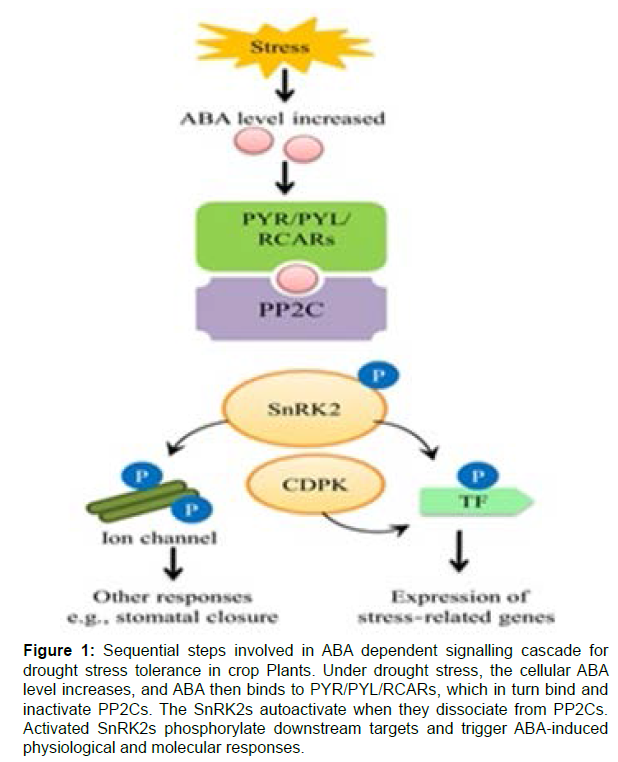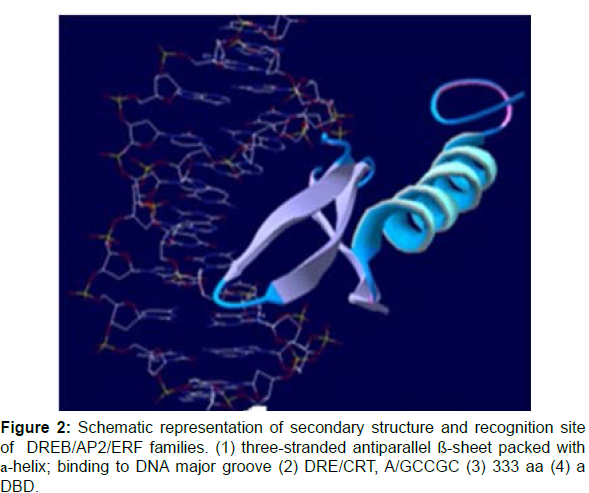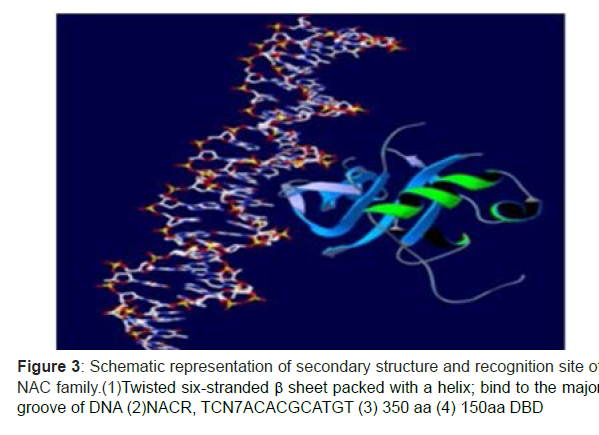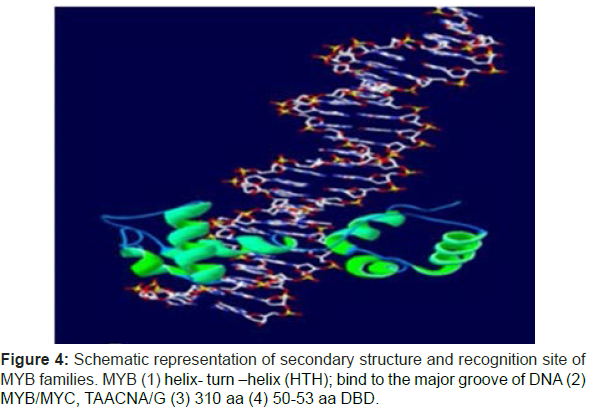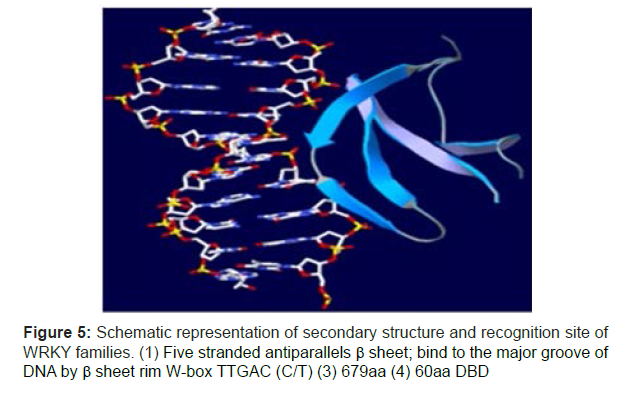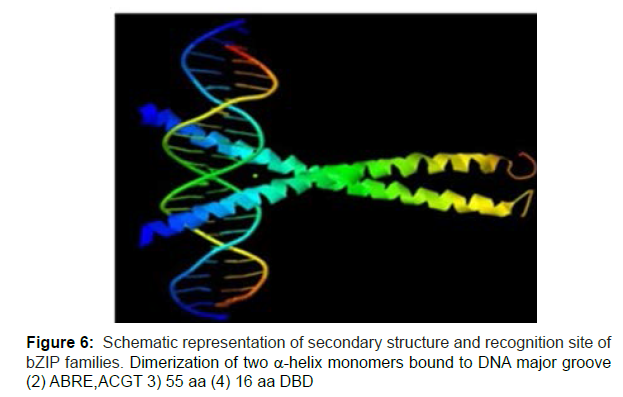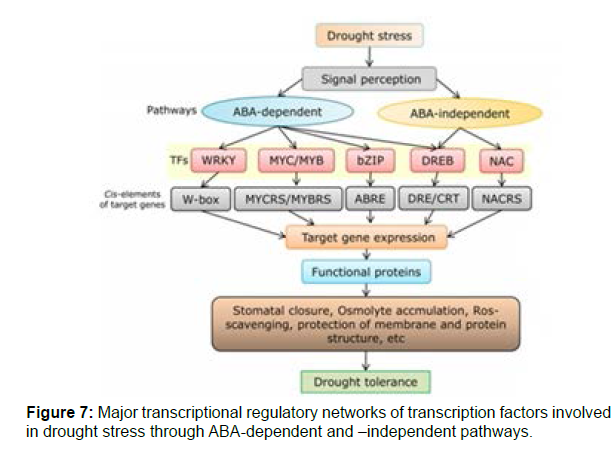Significance of Transcription Factors in Drought Stress Tolerance of Cereal Crops
Received: 09-Mar-2021 / Manuscript No. JPGB-22-27525 / Editor assigned: 02-Jan-2022 / PreQC No. JPGB-22-27525(PQ) / Reviewed: 19-Jan-2022 / QC No. JPGB-22-27525 / Revised: 22-Jan-2022 / Manuscript No. JPGB-22-27525(R) / Accepted Date: 26-Jan-2022 / Published Date: 27-Jan-2022 DOI: 10.4172/jpgb.1000111
Abstract
Drought being a production restrictive factor has become the main threat to international food security. Therefore, understanding the mechanisms underlying the drought response is one of the main scientific agenda for enhancing crop yield. Plants set out different strategies and mechanisms to respond to and tolerate drought stress. The expression of several genes is changed in different plants under drought stress that helps them to optimize their growth and development. Plant hormone abscisic acid (ABA) plays a key role in plant response and tolerance by regulating the expression of many genes under drought stress. Transcription factors being the chief regulator of gene expression play a vital role in stress response. ABA regulates the expression of the majority of the target genes through the ABA-responsive element (ABRE) binding protein/ABRE binding factor (AREB/ABF) transcription factors. Genes regulated by AREB/ABFs comprises a regulon termed as AREB/ABF regulon. In addition to this, drought-responsive genes are also regulated by ABA-independent mechanisms. In ABA-independent regulation, dehydration-responsive element-binding protein (DREB), and NAC regulons play a crucial role by regulating numerous drought-responsive genes. Apart from these key regulons, MYB/MYC, and WRKY, transcription factors family also contributes to drought response and tolerance. Our insight into the transcriptional regulation of drought is still developing. Current findings have suggested the presence of crosstalk between diverse transcription factors functioning under drought stress. In this manuscript, I have reviewed the role of different regulons functioning under drought stress and their crosstalk with each other.
Keywords: Dehydration; Abscisic acid; Transcription factors; Responsive element; Expression
Keywords
Dehydration; Abscisic acid; Transcription factors; Responsive element; Expression
Introduction
Plants are regularly subjected to a broad range of abiotic stresses such as drought, high salinity, heat and extremes of temperature, which seriously affects growth, development and productivity. Of these stresses, drought is one of the most important factors that affect the production of agricultural crops across the worldwide. Drought can cause plant water loss and leaf wilting, and ultimately result in irreversible damaging, plant death. Developing crop performance under a water stress environment is, therefore, the main research focus of plant scientists around the globe. Inadequate water availability induces adaptive physiological responses regulated by changes in the expression of various stress-responsible genes. Plants use complex regulatory pathways to address various stimuli, which include stress sensing, signal transduction, and regulation of stress-responsive genes and/or proteins eventually manifested at the cellular and physiological levels [1].
Transcription factors (TFs) are clusters of proteins that bind to particular regulatory DNA elements situated in gene promoters upstream of transcription initiation sites, repressing or activating many downstream target genes expression. A single TF gene can control the expression of a wide range of target genes (regulon). Transcription factors (TFs) give a possibility for plants to alleviate and respond to biotic and abiotic stresses and are also participate in changing developmental processes. Plant genomes allocate around 7% of their coding sequence to TFs, which shows the complexity of transcriptional regulation. Transcriptome data in many plants advocate that numerous pathways separately respond to stress, showing that stress tolerance or susceptibility is controlled at the transcriptional level by an extremely complex gene regulatory network [1]. TFs concerned with drought response were identified and characterized in different cereal species, such as in rice [2], wheat [3], barley [4], and maize [5]. Underwater limitation in transgenic plants, overexpression of numerous target genes coding for stress-responsive TFs led to enhanced survival rate [6]. The performances of TFs are closely associated with their structure. TFs often comprise a DNA-binding domain (DBD) and a transcriptional activation domain (TAD) [7]. The DBD allows TFs to attach to specific promoter elements of target genes, and TAD intervenes in the control of the downstream gene directly or in association with other proteins. The transcriptional response to water-stress in cereals is controlled by numerous TFs, which have been clustered into some different families based on their structure and binding specificity. The major TFs families are the DRE-binding protein/C-repeat binding factors (DREB/CBF), the NAM/ATAF1/CUC2 (NAC) factors [8], the MYB/MYC family [9], the WRKY family [10], and the basic leucine zipper family (bZIP) [11], and the homeodomain-leucine-zipper (HDZip) family [12].
While plants experience water scarcity, receptors from the cell membrane/cell wall sense the extracellular stress signals and convert them into intracellular secondary messengers such as Ca2+ and inositol phosphate [13]. It is well approved that phyto hormones, in particular abscisic acid (ABA), play a considerable role in drought stress-associated transcription, in most cases through modulating phosphorylation‐status of transcription factors and other regulatory proteins. The objective of this review is to discuss the involvement of TFs in drought response and adaptation in cereals.
Drought-Responsive Signaling Pathways
Plant hormones play vital roles in relating to the stress-responsive signaling flow. ABA is an important plant hormone that utilized as a link between environmental stress reception and adaptive transcriptional program such as the regulation of cellular mechanisms, carbohydrate and lipid metabolism. It is the essential regulator of abiotic stress predominantly drought resistance in plants, and a direct intricate gene regulatory network enabling plants to survive with water deficit [14]. ABA induces the expression of many genes, including late-embryogenesis-abundant (LEA) genes. ABA-dependent signalling pathway has been shown as the system that intervenes stress adaptation by bringing on at least two different regulons: (1) the AREB/ABF (ABAresponsive element-binding protein/ABA-binding factor) regulon; and (2) the MYC (myelocytomatosis)/MYB (myeloblastosis regulon [15]. Whereas ABA-independent regulons are: (1) the CBF/DREB regulon; and (2) the NAC (NAM, ATAF and CUC) [16]. Nevertheless, besides, some investigations have revealed the presence of both ABAdependent and – independent pathways of the stress response that function through AP2/EREBP (ERF) family subsets [17]. Beside these recognized regulons, an enormous other TFs are also participated in abiotic stress response, thus playing a critical role in conferring stress survival to plants. Even though these diverse stress-responsive TFs usually function separately, it is certainly likely that a few levels of cross-talk present between them [18].
There are three main pathways through which drought and ABAmediated signals are perceived via various receptors. The primer receptor PYR/PYL/ RCARs binds ABA and inactions the type 2C protein phosphates (PP2Cs), which leads to the buildup of SNF1- RELATED PROTEIN KINASES (SnRK2s) [19] (Figure 1). SnRK2s in turn trigger ABA-responsive TFs such as Arabidopsis AREB1, AREB2, and AREB3. These TFs regulate ABA-dependent gene expression take part in several physiological processes such as the movement of stomatal guard cells, thus escalating the tolerance to drought. Protein-coupled receptor-type G proteins (GTGs) like GTG1/GTG2 have participated in the second ABA reception pathway, which was initially reported in Arabidopsis. GTG1/GTG2 proteins are membrane-localized receptors with functions in seedling and pollen tube growth and development, acting through voltage-dependent anion channels. The third ABA receptor is the H subunit of Mg-chelatase (CHLH/ABAR), which regulates the lipid metabolism linked to drought tolerance in plants [19].
Figure 1: Sequential steps involved in ABA dependent signalling cascade for
drought stress tolerance in crop Plants. Under drought stress, the cellular ABA
level increases, and ABA then binds to PYR/PYL/RCARs, which in turn bind and
inactivate PP2Cs. The SnRK2s autoactivate when they dissociate from PP2Cs.
Activated SnRK2s phosphorylate downstream targets and trigger ABA‐induced
physiological and molecular responses.
Major Families of Cereal TFs Involved in Drought Response
Transcription factors are categorized into several family groups mostly based on characteristic amino acid sequences of its conserved DBDs [20]. Among these, the families DREB/CBF, NAC, MYB, WRKY, and bZIP are the main TFs that play a part in drought.
DREB/CBF Family
The dehydration responsive element binding proteins (DREBs) family is a part of the AP2/EREBF superfamily of TFs that induce a set of abiotic stress-related genes, thus conferring stress tolerance to plants. These take part in the ABA-independent pathways that trigger stress-responsive genes. DREB/CBF TFs contains around 60 amino acid long AP2 DBD which specifically bind to dehydration-responsive C-repeat (DRE/CRT) cis-element (5'-TACCGACAT-3') and activate expression of genes (Figure 2). In DREB family members, AP2 is an extremely conserved domain throughout the plant kingdom. It possesses two conserved motifs: the YRG and RAYD motifs. The YRG motif is assumed to determine DNA binding and the RAYD motif, which makes α-helix on the C-terminus [21]. DREB/CBF TFs were primarily identified in the promoter of the drought-responsive gene rd29A [22]. They were also found other plant species such as Brassica napus, Triticum aestivum, Atriplex hortensis, and Oryza sativa [23]. DREB1 and DREB2 are two major subgroups of the DREB subfamily, participated in two different signal transduction pathways under cold and dehydration, respectively [24].
TaDREB1 was found to be inducible by drought, salt, low temperature, and ABA in different wheat cultivars [25]. The transgenic barely having TaDREB2 and TaDREB3 [26] demonstrated enhanced tolerance in drought and low-temperature environment. In rice, 13 transcriptional factors including seven DREB1 types and six DREB2 types were isolated and analyzed. ZmDREB1A [27], and ZmDREB2.7 [28] transcription factors contributed to drought tolerance in maize.
NAC Family
The NAC family of plant-specific TFs is one of the largest in the plant genome, with 149 members in rice, [29]. The NAM/ATAF/CUC (NAC) TFs possess a unique feature, a conserved N-terminus DBD and diversified C-terminus regulatory domain and they are distributed across the plant kingdom [20] (Figure 3). NAC is a short form of three genes designated as no apical meristem (NAM), Arabidopsis transcription activation factor (ATAF), and cup-shaped cotyledon (CUC). The cis-element of NAC TF [NAC recognized sequence (NACRS)] was also identified in Arabidopsis [30]. TaNAC2 [31] and TaNAC69 [32] genes are highly expressed under water deficiency and salinity in wheat crop. In maize, ZmNAC052, Zma000584, Zma006493, Zma001259z [33], and ZmSNAC1 showed improved transcription levels of underwater deficiency, demonstrating their potential role in drought tolerance regulation. Besides, the overexpression of OsNAC045, OsNAC6/SNAC2 and SNCA1 [34] encouraged ABA sensitivity and provided drought tolerance in transgenic rice. Hence NAC TFs play an indispensable role in physiological adaptation for successful plant propagation under abiotic stress conditions.
MYB/MYC Family
MYB is a cluster of ancient TFs that existed in eukaryotes such as fungi, animals, and plants known to have various functions [35]. Both MYC/MYB TFs participate in the ABA-dependent pathway of stress signalling for the up-regulation of the abiotic stress-responsive genes. MYC and MYB TFs build up only after ABA accumulation. MYBC1 was the first known gene in a plant, isolated from Zea mays [36]. MYB TFs possess a conserved DBD called MYB domain differentiated by one to three imperfect repeated amino acid sequences (R1, R2, and R3). Each repeat sequence contains about 50–53 amino acids which form three α-helixes [37] (Figure 4). These three α-helices resulted in a helix-turn-helix structure while intercalating in the major groove of DNA. The MYB TFs are mainly categorized into three classes based on the number of the MYB domain repeats: R1-MYB having one MYB repeat, R2R3-MYB containing two flanking repeats, and R1R2R3-MYB comprising three contiguous repeats [38]. These TFs contribute to responses to dehydration or drought [39]. The R2R3 family possesses the largest number of MYB genes [40] have revealed that there are about 183 MYB genes in the rice genomes. ZmMYB-R1 was induced by ABA and drought, in maize [41]. The overexpression of rice genes OsMYB3R-2, OsMYB4, and OsMYB48-1 improved the adaptive response to drought and other stresses in transgenic plants. TaMYB3R1 and TaMYB30-B were found to be potentially taking part in drought adaptation in wheat [42].
WRKY Family
WRKY proteins belong to the superfamily WRKY-GCM1 of zinc finger TFs [43]. They exist in several plant species and were reported to be contributed to several biotic and abiotic stress responses [44]. WRKY family members possess a strongly conserved WRKY domain with 60 amino acids consisted of two motifs. One is the conserved WRKYGQK motif on the N-terminus and the other one is a zinc-finger-like motif on the C-terminus [45] (Figure 5). Based on the different number of WRKY domains and the variable structure of the zinc-finger-like motif, WRKY families are grouped into three key categories. Group I has two WRKY domains, while groups II and III have one WRKY domain. WRKY domain binds to the W box ([T][T]TGAC[C/T]) of target gene promoters to change transcription. The zinc finger motifs of the WRKY domain in group III are different from those of groups I and II [46]. OsWRKY11 was identified to have participated in drought and heat response [47]. OsWRKY45 was assumed to be responsive to ABA and considered to function in stomatal closure to develop drought and salt tolerance [48]. HvWRKY38 was demonstrated to have a role in drought and cold response in barely [49]. In wheat, the overexpression of TaWRKY2 and TaWRKY10 led to improved drought and salt adaptation in transgenic plants [50].
bZIP (AREB/ABF) Family
The basic leucine zipper (bZIP) family is another immense group of TFs that take part in diverse functions such as hormone and sugar signalling and organ development [51]. bZIP proteins usually comprise a basic section for DNA binding and a conserved leucine zipper dimerization motif [52] (Figure 6). These TFs in particular bind to a DNA sequence with a core cis-element ACGT-like TACGTA (A-box), GACGTC (C-box), CACGTG (G-box), and an ABA-responsive element (ABRE) [51]. In plants, bZIP transcription factors provide a different subset of TFs which regulate processes including light and stress signalling, seed maturation, pathogen defence, and flower development. Several bZIP members were known to participate in transducing ABA-dependent stress signals and were known as ABRE binding proteins (AREBs) or ABRE binding factors (ABFs). The AREB or ABFs are bZIP (basic leucine zipper) TFs that bind to the ABRE motif and activate ABA-dependent gene expression were first isolated in a yeast one-hybrid screening [53].
Several bZIP proteins were confirmed to be contributing to abiotic stress response in cereal crops, for instance, 141 in barley, 89 in rice & 171 in maize, and they were categorized into 11 groups A, B, C, D, E, F, G, H, I, S, and U according to the phylogenetic trees and DNA binding motif in maize, rice, and barely. The overexpression of bZIP TFs was recognized to be the response to drought stress in several kinds of cereal. In barley, 11 HvbZIP members were well known to be down-or up-regulated by drought. The overexpression of ZmbZIP37, OsbZIP12 and TabZIP60 in maize, rice and wheat respectively, have shown high expression level in drought stress condition. Similarly, the overexpression of TabZIP60 enhanced drought and frost tolerance in transgenic Arabidopsis [51].
TFs Target Gene Network Activated in Response to Drought
TFs are involved in target gene network regulation through their DBD interaction with different gene promoter cis-elements mediated by ABA-dependent or ABA-independent signal transduction pathway (Figure 7). The majority of DREB family members such as OsDREB1A and TaDREB1 were found to be activated in ABA-independent pathways [23]. They can improve stress tolerance by activating the expression of downstream genes determined by DRE/CRT cis-element. Their expression products in cells safeguard from stresses by increasing the membrane stability and correction of protein folding. However, current studies indicated that some members of DREB also involve in ABA-dependent pathways. DREBs in different species might possess various preferences in regulating the expression of downstream genes with different core elements in their promoters. The rice OsDREB1A, e.g., prefers to interact with the CRT/DRE core element GCCGAC of genes such as cor15A, rd29A, and rd17 instead of core element ACCGAC, while the Arabidopsis DREB1A and maize ZmDREB1A have equal competition for recognizing core element GCCGAC and core element ACCGAC in the downstream genes [23].
In the WRKY family, more than 10 TFs isolated from rice were got to express together under drought and cold stresses, but the downstream genes were still not determined. TaWR‐ KY44 from wheat was identified to recognize the core element (TTGACC/TTAACC) in the promoter region of downstream genes and up-regulate genes encoding stress-defensive proteins such as NtERD10C, to increase plants survival rate in drought [54-57].
Members of the MYB family regulate the expression level of various target genes participated in the ABA-dependent and independent pathways (Figure 7). The overexpression of OsMYB48-1 was existed to regulate genes such as OsPP2C68, RAB21, and OsNCED4, respectively, contributing to ABA early signaling, late response, and the ABA synthesis pathway, contributing to increased drought tolerance under water deficiency. TaMYB30-B was known to induce the expression of stress-inducible genes rd29A and ERD1, contributed to the ABAindependent pathway [42]. Members of the bZIP family were also known to regulate downstream gene transcription via the ABAdependent and independent pathway. OsbZIP52 was believed to bind to G-box cis-elements and down-regulated genes such as OsLEA3 and OsTPP that can enhance drought or cold tolerance in rice via the ABAindependent pathway. The expression of downstream genes LEA3 and Rab16 was activated by the transcription factor OsbZIP12 under water stress mediated by the ABA synthesis pathway [55, 58-61].
The majority of TFs in the NAC family involved in the ABA synthesis pathway (Figure 7). OsNAC5 and OsNAC6 can recognize a core sequence (CACG) of the downstream gene OsLEA3 and regulate the gene expression that altered root structure and conferred strong drought tolerance through the ABA signaling pathway. OsNAC6 also play a part in up-regulating the transcription of genes encoding peroxidase, which can catalyze a series of oxidative reactions. Some TFs even contribute to both ABA-dependent and independent pathways. For instance, TaNAC67 was supposed to up-regulate 10 abiotic stressresponsive genes such as rd29A and rd29B, which were individually associated with ABA-independent and-dependent pathways and four ABA-responsive genes such as ABI1 [31], thus enhance stress tolerance in plants.
Conclusion
In response to abiotic stresses such as drought, a lot of genes are regulated, and their gene products serve in conferring stress tolerance to plants. Considering the molecular mechanisms of plant responses to abiotic stresses is very essential as it makes it possible in utilizing them to advance stress tolerance and output. This manuscript summarizes the role of important plant TFs namely; ABRE, MYC/MYB, CBF/DREBs and NAC that regulate various stress-responsive gene expression. TFs play a crucial role in regulating gene transcription via various signal pathways to allow plants to acclimatize to diverse environments and abiotic stresses such as drought. Those TFs can recognize and interact with specific cis-elements of target genes through DBDs. Some TFs can up-/down-regulate downstream gene transcription, which encodes a member of TFs integrated into phytohormone signalling pathways, developing a complex hierarchic regulatory network. ABA, the main plant hormones, acts as key regulators in balancing plant growth and abiotic stress response. TFs, as the node of the cellular stress network and growth process, function as the interface of different phytohormone signal transduction pathways. These networks of signal pathways are regulating the activity of stress response TFs and other stress-relative genes, which in turn adjust physiological processes, such as stomatal movement, cuticle formation, and carbohydrate and lipid metabolism, to limit water loss and adapt to drought conditions. TFs can be genetically engineered to generate transgenic with higher tolerance to drought, salinity, heat and cold using different promoters. Besides, considering TFs as candidate genes inbreeding and other crop improvement programs will confer us a clear understanding of abiotic stress linked signal transduction events and ultimately will direct us to develop crop varieties advanced in stress tolerance by genetic manipulation.
References
- Umezawa T, Fujita M, Fujita Y, Yamaguchi-Shinozaki K, Shinozaki K (2006) Engineering drought tolerance in plants: discovering and tailoring genes to unlock the future. Curr Opin Biotechnol 17:113-122.
- Nuruzzaman M, Manimekalai R, Sharoni AM, Satoh K, Kondoh H, et al. (2010) Genome-wide analysis of NAC transcription factor family in rice. Gene 465:30-44.
- Kovalchuk N, Jia W, Eini O, Morran S, Pyvovarenko T, et al. (2013) Optimization of TaDREB3 gene expression in transgenic barley using cold‐inducible promoters. Plant Biotechnol J 11:659-670.
- Oh SJ, Kwon CW, Choi DW, Song SI, Kim JK (2007) Expression of barley HvCBF4 enhances tolerance to abiotic stress in transgenic rice. Plant Biotechnol J 5:646-656.
- Wang CT, Dong YM (2009) Overexpression of maize ZmDBP3 enhances tolerance to drought and cold stress in transgenic Arabidopsis plants. Biologia 64:1108-1114.
- Kobayashi F, Maeta E, Terashima A, Kawaura K, Ogihara Y, et al. (2008) Development of abiotic stress tolerance via bZIP-type transcription factor LIP19 in common wheat. J Exp Bot 59:891-905.
- Veerabagu M, Kirchler T, Elgass K, Stadelhofer B, Stahl M, et al. (2014) The interaction of the Arabidopsis response regulator arr18 with bzip63 mediates the regulation of PROLINE DEHYDROGENASE expression. Mol Plant 7:1560-1577.
- Zheng X, Chen B, Lu G, Han B (2009) Overexpression of a NAC transcription factor enhances rice drought and salt tolerance. Biochem Biophys Res Commun 379:985-989.
- Qin Y, Wang M, Tian Y, He W, Han L, et al. (2012) Over-expression of TaMYB33 encoding novel wheat MYB transcription factor increases salt and drought tolerance in Arabidopsis. Mol Biol Rep 39:7183-7192.
- Abe H, Urao T, Ito T, Seki M, Shinozaki K, YamaguchiShinozaki K (2003) Arabidopsis AtMYC2 (bHLH) and AtMYB2 (MYB) function as transcriptional activators in abscisic acid signaling. Plant Cell 15:63-78.
- Liu C, Mao B, Ou S, Wang W, Liu L, et al. (2014) OsbZIP71, a bZIP transcription factor, confers salinity and drought tolerance in rice. Plant Mol Biol 84:19-36.
- Zhao Y, Ma Q, Jin X, Peng X, Liu J, et al. (2014) A novel maize homeodomain-leucine zipper (HD-Zip) I gene, Zmhdz10, positively regulates drought and salt tolerance in both rice and Arabidopsis. Plant Cell Physiol 55:1142-1156.
- Wohlbach DJ, Quirino BF, Sussman MR (2008) Analysis of the Arabidopsis histidine kinase ATHK1 reveals a connection between vegetative osmotic stress sensing and seed maturation. Plant Cell 20:1101–1117.
- Kim TH, Bohmer M, Hu HH, Nishimura N, Schroeder JI (2010) Guard Cell signal transduction Network advances in understanding abscisic Acid, CO2, and Ca2+ signaling. Annu Rev Plant Biol 61:561-591.
- Saibo NJM, Lourenco T, Oliveira MM (2009) Transcription factors and regulation of photosynthetic and related metabolism under environmental stresses. Ann Bot 103:609-623.
- Nakashima K, Ito Y, Yamaguchi-Shinozaki K (2009) Transcriptional Regulatory Networks in Response to Abiotic Stresses in Arabidopsis and Grasses. Plant Physiol 149:88–95.
- Kizis D, Pagès M (2002) Maize DRE-binding proteins DBF1 and DBF2 are involved in rab17 regulation through the drought-responsive element in an ABA-dependent pathway. Plant J 30:679-689.
- Blattler A, Farnham PJ (2013) Cross-talk between site-specific transcription factors and the DNA methylation states. J Biol Chem 288:34287– 34294.
- Golldack D, Li C, Mohan H, Probst N (2014) Tolerance to drought and salt stress in plants: Unraveling the signalling networks. Front Plant Sci 5.
- Wang ZY, Dane F (2013) NAC (NAM/ATAF/CUC) transcription factors in different stresses and their signaling pathway. Acta Physiologiae Plantarum 35:1397-1408.
- Kizis D, Lumbreras V, Pagès M (2001) Role of AP2/EREBP transcription factors in gene regulation during abiotic stress. FEBS Letters 498:187-189.
- Yamaguchi-Shinozaki K, Shinozaki K (1993) The plant hormone abscisic acid mediates the drought-induced expression but not the seed-specific expression of rd22, a gene responsive to dehydration stress in Arabidopsis thaliana. Mol Gen Genet 238:17-25.
- Dubouzet JG, Sakuma Y, Ito Y, Kasuga M, Dubouzet EG, et al. (2003) OsDREB genes in rice, Oryza sativa L., encode transcription activators that function in drought, high‐salt‐and cold‐responsive gene expression. Plant J 33:751-763.
- Eckardt NA (2019) DREB Duo Defines Distinct Drought and Cold Response Pathways. Plant Cell 31:1196–1197.
- Shen YG, Zhang WK, He SJ, Zhang JS, Liu Q, et al. (2003) An EREBP/AP2-type protein in Triticum aestivum was a DRE-binding transcription factor induced by cold, dehydration and ABA stress. Theor Appl Genet 106:923-930.
- Morran S, Eini O, Pyvovarenko T, Parent B, Singh R, et al. (2011) Improvement of stress tolerance of wheat and barley by modulation of expression of DREB/CBF factors. Plant Biotechnol J 9:230-249.
- Qin F, Sakuma Y, Li J, Liu Q, Li YQ, Shinozaki K, et al. (2004) Cloning and functional analysis of a novel DREB1/CBF transcription factor involved in cold-responsive gene expression in Zea mays L. Plant and Cell Physiol 45:1042-1052.
- Liu S, Wang X, Wang H, Xin H, Yang X, et al. (2013) Genome-wide analysis of ZmDREB genes and their association with natural variation in drought tolerance at seedling stage of Zea mays L. PLOS Genet 9:e1003790.
- Xiong Y, Contento AL, Bassham DC (2005) AtATG18a is required for the formation of autophagosomes during nutrient stress and senescence in Arabidopsis thaliana. Plant J 42:535-546.
- Tran LSP, Nakashima K, Sakuma Y, Simpson SD, Fujita Y, et al. (2004) Isolation and functional analysis of Arabidopsis stress-inducible NAC transcription factors that bind to a drought responsive cis-element in the early responsive to dehydration stress 1 promoter. Plant Cell 16:2481-2498.
- Mao X, Chen S, Li A, Zhai C, Jing R (2014) Novel NAC transcription factor TaNAC67 confers enhanced multi-abiotic stress tolerances in Arabidopsis. PloS One 9:e84359.
- Xue Y, Rushton MD, Maringele LA (2011) A Novel checkpoint and RPA inhibitory pathway regulated by Rif1. PLoS Genet 7:e1002417.
- Lu M, Sun Q, Zhang D, Wang T, Pan J (2015) Identification of 7 stress-related NAC transcription factor members in maize (Zea mays L.) and characterization of the expression pattern of these genes. Biochem Biophys Res Commun 462:144-150.
- Zheng Y, Guo J, Li X, Xie Y, Hou M, et al. (2014) An integrated overview of spatiotemporal organization and regulation in mitosis in terms of the proteins in the functional super complexes. Front Microbiol 5:573.
- Lipsick JS (1996) One billion years of Myb. Oncogene 13:223-235.
- Paz-Ares J, Ghosal D, Wienand U, Peterson P, Saedler H (1987) The regulatory c1 locus of Zea mays encodes a protein with homology to myb proto-oncogene products and with structural similarities to transcriptional activators. EMBO J 6:3553.
- Du H, Zhang L, Liu L, Tang X, Yang W, et al. (2009) Biochemical and molecular characterization of plant MYB transcription factor family. Biochem 74:1-11.
- Stracke R, Werber M, Weisshaar B (2001) The R2R3-MYB gene family in Arabidopsis thaliana. Curr Opin Plant Biol 4: 447–456.
- Shinozaki K, Yamaguchi-Shinozaki K, Seki M (2003) Regulatory network of gene expression in the drought and cold stress responses. Curr Opin Plant Biol 6:410-417.
- Yanhui C, Xiaoyuan Y, Kun H, Meihua L, Jigang L, et al. (2006) The MYB transcription factor superfamily of Arabidopsis: expression analysis and phylogenetic comparison with the rice MYB family. Plant Mol Biol 60:107–124.
- Liu L, Hao Z, Weng J, Li M, Zhang D, et al. (2012) Identification of drought responsive genes by cDNA‐amplified fragment length polymorphism in maize. Annals Applied Biol 161:203-213.
- Zhang L, Zhao G, Xia C, Jia J, Liu X, et al. (2012) A wheat R2R3-MYB gene, TaMYB30-B, improves drought stress tolerance in transgenic Arabidopsis. J Exp Bot 63:5873-5885.
- Babu MM, Iyer LM, Balaji S, Aravind L (2006) The natural history of the WRKY–GCM1 zinc fingers and the relationship between transcription factors and transposons. Nucleic Acids Res 34:6505-6520.
- Chen L, Song Y, Li S, Zhang L, Zou C, Yu D (2012) The role of WRKY transcription factors in plant abiotic stresses. Biochim Biophys Acta 1819:120-128.
- Eulgem T, Rushton PJ, Robatzek S, Somssich IE (2000) The WRKY superfamily of plant transcription factors. Trends in Plant Sci 5:199-206.
- Chen C, Chen Z (2000) Isolation and characterization of two pathogen and salicylic acid-induced genes encoding WRKY DNA-binding proteins from tobacco. Plant Mol Biol 42:387–396.
- Wu X, Shiroto Y, Kishitani S, Ito Y, Toriyama K (2009) Enhanced heat and drought tolerance in transgenic rice seedlings overexpressing OsWRKY11 under the control of HSP101 promoter. Plant Cell Rep 28:21-30.
- Qiu Y, Yu D (2009) Over-expression of the stress-induced OsWRKY45 enhances disease resistance and drought tolerance in Arabidopsis. Environ and Exp Bot 65:35-47.
- Mare C, Mazzucotelli E, Crosatti C, Francia E, Cattivelli L (2004) Hv-WRKY38: A new transcription factor involved in cold-and drought-response in barley. Plant Mol Biol 55:399-416.
- Wang C, Deng P, Chen L, Wang X, Ma H, et al. (2013) A wheat WRKY transcription factor TaWRKY10 confers tolerance to multiple abiotic stresses in transgenic tobacco. PlosOne 8:e65120.
- Zhang L, Zhang L, Xia C, Zhao G, Liu J, et al. (2015) A novel wheat bZIP transcription factor, TabZIP60, confers multiple abiotic stress tolerances in transgenic Arabidopsis. Physiol Plant, 153:538-554.
- Jakoby M, Weisshaar B, Dröge-Laser W, Vicente-Carbajosa J, Tiedemann J, et al. (2002) bZIP transcription factors in Arabidopsis. Trends in Plant Sci 7:106-111.
- Choi H, Hong J, Ha J, Kang J, Kim SY (2000) ABFs, a family of ABA-responsive element binding factors. J Biol Chem 275:1723–1730.
- Wang J, Hu Z, Zhao T, Yang Y, Chen T, et al. (2015) Genome-wide analysis of bHLH transcription factor and involvement in the infection by yellow leaf curl virus in tomato (Solanum lycopersicum). BMC Genomics 16:39.
- Joo J, Lee YH, Song SI (2014) Overexpression of the rice basic leucine zipper transcription factor OsbZIP12 confers drought tolerance to rice and makes seedlings hypersensitive to ABA. Plant Biotechnol Rep 8:431-441.
- Kang JY (2002) Arabidopsis basic leucine zipper proteins that mediate stress-responsive abscisic acid signaling. Plant Cell 14:343-357.
- Mao X, Zhang H, Qian X, Li A, Zhao G, Jing R (2012) TaNAC2, a NAC-type wheat transcription factor conferring enhanced multiple abiotic stress tolerances in Arabidopsis. J Exp Bot 63:2933-2946.
- Niu CF, Wei W, Zhou QY, Tian AG, Hao YJ, et al. (2012) Wheat WRKY genes TaWRKY2 and TaWRKY19 regulate abiotic stress tolerance in transgenic Arabidopsis plants. Plant Cell Environ 35:1156–1170.
- Qin L, Wang L, Guo Y, Li Y, Umut H, et al. (2017) An ERF transcription factor from Tamarix hispida, ThCRF1, can adjust osmotic potential and reactive oxygen species scavenging capability to improve salt tolerance. Plant Sci 265:154–166.
- Zhao L, Hu Y, Chong K, Wang T (2010)
Citation: Tesfa M (2022) Significance of Transcription Factors in Drought Stress Tolerance of Cereal Crops. J Plant Genet Breed 6: 111 DOI: 10.4172/jpgb.1000111
Copyright: © 2022 Tesfa M. This is an open-access article distributed under the terms of the Creative Commons Attribution License, which permits unrestricted use, distribution, and reproduction in any medium, provided the original author and source are credited.
Indexed at Google Scholar Crossref
Indexed at Google Scholar Crossref
Indexed at Google Scholar Crossref
Indexed at Google Scholar Crossref
Indexed at Google Scholar Crossref
Indexed at Google Scholar Crossref
Indexed at Google Scholar Crossref
Indexed at Google Scholar Crossref
Indexed at Google Scholar Crossref
Indexed at Google Scholar Crossref
Indexed at Google Scholar Crossref
Indexed at Google Scholar Crossref
Indexed at Google Scholar Crossref
Indexed at Google Scholar Crossref
Indexed at Google Scholar Crossref
Indexed at Google Scholar Crossref
Indexed at Google Scholar Crossref
Indexed at Google Scholar Crossref
Indexed at Google Scholar Crossref
Indexed at Google Scholar Crossref
Indexed at Google Scholar Crossref
Indexed at Google Scholar Crossref
Indexed at Google Scholar Crossref
Indexed at Google Scholar Crossref
Indexed at Google Scholar Crossref
Indexed at Google Scholar Crossref
Indexed at Google Scholar Crossref
Indexed at Google Scholar Crossref
Indexed at Google Scholar Crossref
Indexed at Google Scholar Crossref
Indexed at Google Scholar Crossref
Indexed at Google Scholar Crossref
Indexed at Google Scholar Crossref
Indexed at Google Scholar Crossref
Indexed at Google Scholar Crossref
Indexed at Google Scholar Crossref
Indexed at Google Scholar Crossref
Indexed at Google Scholar Crossref
Indexed at Google Scholar Crossref
Indexed at Google Scholar Crossref
Indexed at Google Scholar Crossref
Indexed at Google Scholar Crossref
Indexed at Google Scholar Crossref
Indexed at Google Scholar Crossref
Indexed at Google Scholar Crossref
Indexed at Google Scholar Crossref
Indexed at Google Scholar Crossref
Indexed at Google Scholar Crossref
Indexed at Google Scholar Crossref
Indexed at Google Scholar Crossref
Indexed at Google Scholar Crossref
Indexed at Google Scholar Crossref
Indexed at Google Scholar Crossref
Indexed at Google Scholar Crossref
Indexed at Google Scholar Crossref
Indexed at Google Scholar Crossref
Indexed at Google Scholar Crossref
Select your language of interest to view the total content in your interested language
Share This Article
Open Access Journals
Article Tools
Article Usage
- Total views: 4381
- [From(publication date): 0-2022 - Nov 13, 2025]
- Breakdown by view type
- HTML page views: 3618
- PDF downloads: 763

